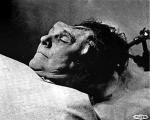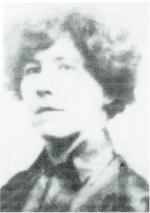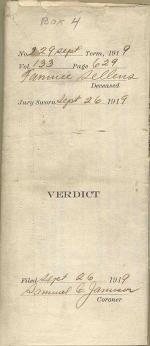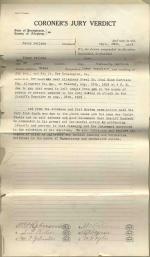![header=[Marker Text] body=[An organizer for the United Mine Workers, Fannie Sellins was brutally gunned down in Brackenridge on the eve of a nationwide steel strike, on August 26, 1919. Her devotion to the workers' cause made her an important symbolic figure. Both she and Joseph Starzelski, a miner who was also killed that same day, lie buried here in Union Cemetery where a monument to the pair was erected. ] sign](http://explorepahistory.com/kora/files/1/10/1-A-244-139-ExplorePAHistory-a0h6x1-a_450.jpg)
Mouse over for marker text
Name:
Fannie Sellins
Region:
Pittsburgh Region
County:
Westmoreland
Marker Location:
Front of Union Cemetery, PA 366, Arnold
Dedication Date:
June 15, 2004
Behind the Marker
Fannie Sellins lived a life and died a death straight out of the pages of The Autobiography of Mother Jones. Mary Harris Jones, known universally as  "Mother Jones," faced down countless gun-toting deputies and spoke often of her own mortality, yet she lived through the labor battles to old age. Killed while organizing coal miners in 1919, Fannie Sellins became a great martyr for labor. "I often wonder it wasn't me they got," Mother Jones reflected, "Whenever I look at the picture of her I wonder it's not me lying on the ground."
"Mother Jones," faced down countless gun-toting deputies and spoke often of her own mortality, yet she lived through the labor battles to old age. Killed while organizing coal miners in 1919, Fannie Sellins became a great martyr for labor. "I often wonder it wasn't me they got," Mother Jones reflected, "Whenever I look at the picture of her I wonder it's not me lying on the ground."
Fannie Sellins was born Frances Mooney in Ohio in 1867. In St. Louis she married Charles Sellins, and after his death worked in a garment factory to support her four children. There, helping organize a United Garment Workers local, she came to the attention of the district president of the United Mine Workers.
In 1913 she went to work for the mineworkers union in West Virginia. Three years later, she moved to the Allegheny-Kiskiminetas valley, the "black valley," and successfully recruited miners of different ethnicities into the union.
Surviving accounts of her brutal death are maddeningly inconsistent. We know that miners that summer were striking against the Allegheny Coal and Coke Company and that there was a showdown on August 26 between company guards and the strikers outside the company's mine in Brackenridge. Tensions accompanying a steel organizing effort were felt across the district.
No one really knows what happened to Fannie Sellins. One widely circulated account tells an especially dramatic tale that may or may not be true. Sellins in this account was a fearless and passionate organizer who had been recording and denouncing picket line violence on the part of the companies' hired guns.
Accompanying a group of women and children, she intervened during a confrontation between mine guards and picketers who were being clubbed. She apparently went to the aid of a fallen picketer, Joseph Starzelski, who had been shot and was dying.
The police turned on Sellins and chased her into the yard of a miner's family, where she was either shot or clubbed from behind trying to escape through a backyard gate. She was then flipped over, face up against a large rock, and shot in the face. Deputies proceeded to mock her in this account, dancing before a crowd of mining families, wearing her hat and throwing her body into their vehicle like a sack of potatoes. An estimated crowd of 10,000 marched in her funeral procession.
The coroner's report on her body reads, rather tersely, "I find two (2) gunshot wounds of the head, on the left side," a "depressed fracture . . . above the left eye," and a "linear fracture . . . above the right ear." The two deputies tried for the killings were acquitted in 1923.
In 1920, the United Mine Workers raised a graveside memorial to Sellins. Stories told down the years about her brutal murder have increased appreciation for her role in the labor movement. Anne Feeney, a labor songwriter and present-day "hell raiser," sings about her, "She fought with tireless energy, no duty would she shirk / Though murderers cut short her life - we carry on her work."
Fannie Sellins was born Frances Mooney in Ohio in 1867. In St. Louis she married Charles Sellins, and after his death worked in a garment factory to support her four children. There, helping organize a United Garment Workers local, she came to the attention of the district president of the United Mine Workers.
In 1913 she went to work for the mineworkers union in West Virginia. Three years later, she moved to the Allegheny-Kiskiminetas valley, the "black valley," and successfully recruited miners of different ethnicities into the union.
Surviving accounts of her brutal death are maddeningly inconsistent. We know that miners that summer were striking against the Allegheny Coal and Coke Company and that there was a showdown on August 26 between company guards and the strikers outside the company's mine in Brackenridge. Tensions accompanying a steel organizing effort were felt across the district.
No one really knows what happened to Fannie Sellins. One widely circulated account tells an especially dramatic tale that may or may not be true. Sellins in this account was a fearless and passionate organizer who had been recording and denouncing picket line violence on the part of the companies' hired guns.
Accompanying a group of women and children, she intervened during a confrontation between mine guards and picketers who were being clubbed. She apparently went to the aid of a fallen picketer, Joseph Starzelski, who had been shot and was dying.
The police turned on Sellins and chased her into the yard of a miner's family, where she was either shot or clubbed from behind trying to escape through a backyard gate. She was then flipped over, face up against a large rock, and shot in the face. Deputies proceeded to mock her in this account, dancing before a crowd of mining families, wearing her hat and throwing her body into their vehicle like a sack of potatoes. An estimated crowd of 10,000 marched in her funeral procession.
The coroner's report on her body reads, rather tersely, "I find two (2) gunshot wounds of the head, on the left side," a "depressed fracture . . . above the left eye," and a "linear fracture . . . above the right ear." The two deputies tried for the killings were acquitted in 1923.
In 1920, the United Mine Workers raised a graveside memorial to Sellins. Stories told down the years about her brutal murder have increased appreciation for her role in the labor movement. Anne Feeney, a labor songwriter and present-day "hell raiser," sings about her, "She fought with tireless energy, no duty would she shirk / Though murderers cut short her life - we carry on her work."








